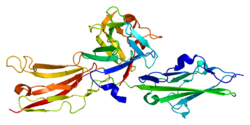Top Qs
Timeline
Chat
Perspective
FGF10
Protein-coding gene in humans From Wikipedia, the free encyclopedia
Remove ads
Fibroblast growth factor 10 is a protein that in humans is encoded by the FGF10 gene.[5][6] It is a polypeptide of 208 amino acids.[7] Human FGF10 gene is highly homologous (95.6%) to rat FGF10, where it was first discovered.[8]
Remove ads
Function
Summarize
Perspective
The protein encoded by this gene is a member of the fibroblast growth factor (FGF) family. FGF family members possess broad mitogenic and cell survival activities, and are involved in a variety of biological processes, including embryonic development, cell growth, morphogenesis, tissue repair, tumor growth and invasion. Fibroblast growth factor 10 is a paracrine signaling molecule seen first in the limb bud and organogenesis development. FGF10 starts the developing of limbs and is involved in the branching of morphogenesis in multiple organs such as the lungs, skin, ear and salivary glands. During limb development Tbx4/Tbx5 stimulate the production of FGF10 in the lateral plate mesoderm where it will create an epithelial-mesenchymal FGF signal with FGF8. This positive feedback loop will increase the amount of mesenchyme resulting in a bulge. Afterwards, FGF10 will induce the formation of apical ectodermal ridge (AER) where the feet and hands will be formed. Lung development uses the same epithelial-mesenchymal signaling from FGF10 in the foregut mesenchyme with FGFR2 in the foregut epithelium. FGF10 signaling is required for epithelial branching. Therefore, all branching morphogen organs such as the lungs, skin, ear and salivary glands required the constant expression of FGF10. This protein exhibits mitogenic activity for keratinizing epidermal cells, but essentially no activity for fibroblasts, which is similar to the biological activity of FGF7.[6]
Remove ads
Clinical significance
Nonsense mutations may also occur with the absence of FGF10 such as LADD and ALSG syndrome. Nevertheless, complications may arise from FGF10 signaling such as pancreatic and breast cancer. Moreover, studies have identified variants near the FGF10 locus as a genetic risk factor for breast cancer susceptibility.[9] Although this gene is also implicated to be a primary factor in the process of wound healing.[6] Heterozygous FGF10 variants and childhood intestinal lung disease (child) linked to potential early lethal outcomes. Also, FGF10 variants have been associated with abnormal epithelial repair.[10] FGF10 haploinsufficiency has been shown to increase the risk of chronic‐obstructive pulmonary disease (COPD). Individuals with haploinsufficiency for FGF10 have significantly reduced Tiffeneau index, resembling chronic restrictive and obstructive pulmonary disease. [11]
Remove ads
Animal studies
FGF10 knockout mice die right after birth. The mice showed no developing organs such as lungs, salivary glands, kidney or definitive limbs once autopsied. Studies of the mouse homolog suggested that this gene is required for embryonic epidermal morphogenesis including brain development, lung morphogenesis, and initiation of limb bud formation.[12] FGF knockout mice also have impaired epicardial cell expansion following neonatal heart injury, as well as reduced expression of epicardial markers Wt1 and Tbx18, and mesenchymal markers such as Snai1, Twist1, and Postn.[13] Mice deficient in FGF10 fail to develop normal mammary glands. [14] Guinea Pig model has shown that the FGF10 monoclonal antibody can decrease the number of inflammatory cells in the dermis and its inhibitory effect on inflammatory cells is like that of hydrocortisone butyrate. [15]
Interactions
FGF10 has been shown to interact with Heparan sulfate [16] and Toll-like receptors. [17]
See also
References
Further reading
External links
Wikiwand - on
Seamless Wikipedia browsing. On steroids.
Remove ads





